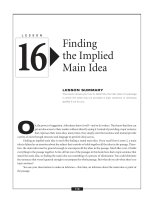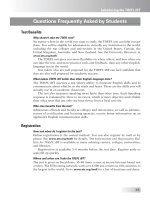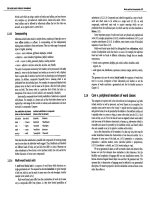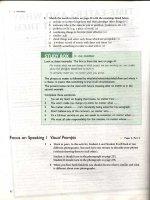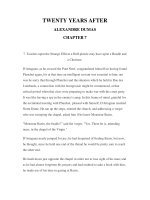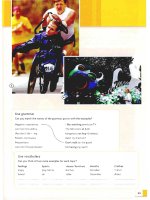Finding main idea 7 ppsx
Bạn đang xem bản rút gọn của tài liệu. Xem và tải ngay bản đầy đủ của tài liệu tại đây (72.97 KB, 6 trang )
W
e spend a good deal of our lives comparing and contrasting things. Whenever we want to explain
something, for example, we often use comparison (showing how two or more things are
similar). We might say, for example, that mint chocolate chip ice cream tastes just like a York
Peppermint Pattie; or that the new manager looks just like Clint Eastwood. When we want to show how things
are different or not alike, we contrast them. We might say that York Peppermint Patties are mintier than any mint
chocolate chip ice cream; or that the new manager may look like Eastwood, but he doesn’t have Eastwood’s dimple.
LESSON
Similarities and
Differences:
Compare and
Contrast
LESSON SUMMARY
This lesson explores another organizational pattern writers often use to
structure their writing: comparison and contrast.
8
67
How Comparison and
Contrast Work
When writers compare and contrast, they provide a way
of classifying or judging the items they are discussing.
They show how two (or more) things are similar or dif-
ferent when placed side by side. Consider, for example,
the following paragraph. Read it carefully, and then
answer the questions that follow.
Planting a garden is a lot like having a family. Both
require a great deal of work, especially as they grow
and as the seasons change. As summer days
lengthen, your plants become dependent on you for
sustenance, much like your children depend on you
for food and drink. Like a thirsty child asking for a
drink of water, your plants do the same. Their bent,
wilted “body” language, translated, issues a demand
much the way your child requests milk or juice.
When their collective thirsts are quenched, you see
the way they both thrive in your care. The fussy
child becomes satisfied, and the plant reaches toward
the sun in a showy display. You might also find that
you have to clean the space around your plants much
like you would pick up toys and clothes that have
been thrown helter-skelter in your toddler’s room.
Similarly, plants shed spent petals, roses need to be
pruned, and weeds need to be pulled. To keep chil-
dren healthy, parents protect their children against
disease with medicine, and gardeners do the same
with insect repellent. To nourish them, parents give
children vitamins, and gardeners use fertilizer, as
both promote healthy growth. As children grow and
become adults, they need less and less care. However,
here’s where the similarity ends. While plants die and
become dormant during winter, children still main-
tain a vital role in the family unit.
Finding the Facts
1. What two things are being compared and
contrasted here?
2. In what ways are these two things similar?
(There are four similarities; list them here.)
a.
b.
c.
d.
3. In what ways are these two things different?
(There is one aspect that is different; write it
here.)
Answers
1. The two things being compared and contrasted are
a parent and a gardener.
2. Gardeners are like parents in that: a) plants are
dependent on gardeners as children are on parents;
b) plants require care from gardeners as children
do from their parents; c) gardeners tidy up after
their plants, as parents do after children; and d)
gardeners protect their plants, as parents protect
their children.
3. Gardeners are unlike parents in that their respon-
sibility for their plants ends when the plant dies or
goes into winter dormancy.
– SIMILARITIES AND DIFFERENCES: COMPARE AND CONTRAST–
68
Finding the Main Idea
Now that you’ve answered those questions, consider
one more. Read the previous passage again, and then
answer this question:
4. What is the main idea of this passage?
Did you notice that the opening sentence, “Planting
a garden is a lot like having a family,” is the topic sen-
tence that expresses the main idea of this paragraph?
The paragraph does mention a
difference
between these
two roles, but notice that the topic sentence does not
claim that gardeners and parents are
exactly
alike.
Instead, it asserts that they are “a lot”alike.
Transitional Devices
As you read the paragraph about gardeners and parents,
did you notice the transitional words and phrases that
show you when the writer is comparing (showing sim-
ilarity) and when the writer is contrasting (showing dif-
ference)? Here’s the passage once more. As you read it
this time, underline the transitional words and phrases
you find.
Planting a garden is a lot like having a family. Both
require a great deal of work, especially as they grow and
as the seasons change. As summer days lengthen, your
plants become dependent on you for sustenance,
much like your children depend on you for food and
drink. Like a thirsty child asking for a drink of water,
your plants do the same. Their bent, wilted “body”
language, translated, issues a demand much the way
your child requests milk or juice. When their collective
thirsts are quenched, you see the way they both thrive
in your care. The fussy child becomes satisfied, and the
plant reaches toward the sun in a showy display. You
might also find that you have to clean the space around
your plants much like you would pick up toys and
clothes that have been thrown helter-skelter in your
toddler’s room. Similarly, plants shed spent petals,
roses need to be pruned, and weeds need to be pulled.
To keep children healthy, parents protect their children
against disease with medicine, and gardeners do the
same with insect repellent. To nourish them, parents
give children vitamins, and gardeners use fertilizer, as
both promote healthy growth. As children grow and
become adults, they need less and less care. However,
here’s where the similarity ends. While plants die and
become dormant during winter, children still maintain
a vital role in the family unit.
There are several transitional words and phrases
writers use to show comparison and contrast. In this
paragraph, you should have underlined the following
words: much like, in the same way, similarly, and however.
These words and phrases show similarity:
These words and phrases show difference:
but
on the other hand
however
conversely
yet
on the contrary
nevertheless
similarly
likewise
like
just as
in the same way
in a like manner
and
also
– SIMILARITIES AND DIFFERENCES: COMPARE AND CONTRAST–
69
Structure
Now look more closely at the sample paragraph to
examine its structure. Exactly how is this paragraph
organized?
First, you’ve noticed that the paragraph begins
with a topic sentence that makes the initial comparison:
“Gardeners are like parents.”Then, the paragraph iden-
tifies four ways in which gardeners are like parents:
1. Plants become dependent upon gardeners as
children do on parents.
2. Plants require care from their gardeners as chil-
dren do from parents.
3. Gardeners clean up after their plants as parents
do after children.
4. Gardeners protect plants from “dangers” as par-
ents protect children.
Finally, after pointing out these similarities, the
paragraph concludes by pointing out an important
difference between parents and gardeners:
1. A gardener’s responsibility for his or her plants
ends with time while a parent’s doesn’t.
Perhaps you noticed something else in the way
this paragraph is organized. Did you notice that every
time the paragraph mentions something about a par-
ent’s role, it also mentions something about a gar-
dener? Each aspect of the gardener’s role is followed by
a comparable aspect of the parent’s role. Thus, for
every aspect of “A” (the gardener), the paragraph pro-
vides a comparable aspect of “B” (the parent) to com-
pare or contrast. The paragraph is therefore organized
like this: ABABABABAB.
This is called the point-by-point method of com-
parison and contrast. Each aspect of A discussed is
immediately paired with that aspect of B (being
dependent, requiring care, cleaning up, and protecting).
On the other hand, some writers prefer to deal
first with all aspects of A and then with all aspects of B.
This is called the block method of comparison and con-
trast; it goes AAAAABBBBB. Here is the same para-
graph arranged using the block method:
Planting a garden is a lot like having a family. A
plant becomes dependent on the gardener and
begs for water on a hot summer day. Gardeners
also have to clean up the space around their plants
as they shed spent petals, as they require pruning,
and as they become choked with weeds. Garden-
ers also provide for the health of their plants
through insecticide and fertilizer applications. A
gardener’s responsibility for his or her plants
lessens as they die at the end of the season or they
go into winter dormancy.
Like a gardener, a parent finds their children
dependent upon them for food and nourishment.
Like a gardener, a parent is constantly picking up
after their children, as toys and clothes are scattered
throughout the house. Like a gardener, a parent pro-
vides for the nourishment and well-being of their
children with vitamin supplements, food, and med-
icines. However, unlike gardeners, parents will find
that their responsibility lessens as the child grows,
but it does not come to an end.
Here, the passage treats each of the things being
compared and contrasted separately—first, all aspects
of the gardener, then all aspects of the parent—rather
than one aspect of the gardener, one of the parent;
another of the gardener, another of the parent. So the
organization is quite different.
But you should notice one thing that is similar in
both passages: They compare and contrast aspects of A
and B that are comparable or parallel. When an aspect of
A is discussed, that same aspect of B (whether similar
to or different from A) must be discussed. This corre-
spondence of parts is essential for the compare and
contrast technique. Look what happens, for example,
when the writer does not discuss corresponding parts:
– SIMILARITIES AND DIFFERENCES: COMPARE AND CONTRAST–
70
Being a parent is a lot like being a gardener. Parents
must bathe, clothe, and feed their children. Parents
must also create and maintain guidelines for accept-
able behavior for children. Also, parents must see to
it that their children get a proper education.
Gardeners nurture the plants in their gardens.
They pull weeds and prune them to encourage them
to grow. They feed them and apply insecticides.
They watch them flower and then witness their
demise.
You’ll notice that this passage seems to focus on
differences between gardeners and parents rather than
the similarities. But is this really a fair contrast? Look at
the aspects of A (the gardener) that are described here.
Do they have any relationship to the aspects of B (the
parent) that are described? No. And a compare and con-
trast passage can’t be successful unless the aspects of A
and B are discussed comparably. These two paragraphs
don’t really seem to have a point—there’s no basis for
comparison between gardeners and parents.
Practice
Suppose you were going to write a paragraph that com-
pares and contrasts readers and detectives. The fol-
lowing are five aspects of being a reader and five aspects
of being a detective listed. Only three items in each list
are comparable. Find those three items in each list and
pair them with their matching item. Remember, these
items may be either similarities or differences. What’s
important is that they are comparable aspects.
A reader:
1. Looks for clues to meaning.
2. Has many different types of books to read.
3. Can choose what book to read.
4. Builds vocabulary by reading.
5. Becomes a better reader with each book.
A detective:
1. Has a dangerous job.
2. Gets better at solving crimes with each case.
3. Requires lots of training.
4. Doesn’t get to choose which cases to work on.
5. Looks for clues to solve the crime.
Did you find the aspects that are comparable?
Did you match reader 1 with detective 5 (similarity)?
Reader 3 with detective 4 (difference)? And reader 5
with detective 2 (similarity)? If so, you did terrific work.
Here’s how this information might work together
in a paragraph:
In many ways, readers are a lot like detectives. Like
detectives looking for clues at the scene of the crime,
readers look for clues to meaning in the books that
they read. And, like detectives who get better and
better at solving crimes with each case, readers get
better and better at understanding what they read
with each book. Unfortunately for detectives, how-
ever, they cannot choose which cases they get to
work on, whereas readers have the pleasure of choos-
ing which books they’d like to read.
Why Compare and Contrast?
In addition to following the ABABAB or AAABBB
structure, compare and contrast passages must, like all
other passages, have a point. There’s a reason that these
two items are being compared and contrasted; there’s
something the writer is trying to point out by putting
these two things side by side for analysis. This reason or
point is the main idea, which is often stated in a topic
sentence.
– SIMILARITIES AND DIFFERENCES: COMPARE AND CONTRAST–
71
